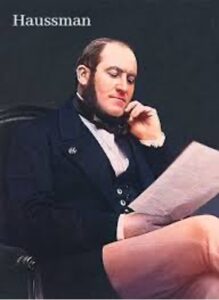Georges-Eugène Haussmann:
The Architect of Modern Paris

Georges-Eugène Haussmann (1809–1891) was a civic planner who, during the reign of Napoleon III, led a vast renovation of the city in 1853.
He had no formal architectural training. His working experience was in administration and law. In one way, that worked in his favor in that his knowledge of how to make things happen in Napolean’s government, combined with a reputation as a demanding, almost authoritarian task master, allowed him to get done in a few short years what should have been impossible.
Haussmann’s Mandate:
Renovating Paris was Napoleon III’s idea. Before the transformation, it was a fast-growing, densely populated, and historically important city that was dirty, decaying, and dysfunctional. The mandate he gave Haussmann was to make it modern, clean, and beautiful – and to get it done asap.
Among his many accomplishments, Haussmann replaced the city’s ancient and unsanitary sewer and water systems with an underground network that significantly improved public health. He widened many of the city’s narrow, medieval streets, and added the grand, tree-lined avenues that define Paris today.
Another major contribution that Haussmann made to Paris was the introduction of public parks and squares. Our favorites: Bois de Boulogne, Bois de Vincennes, Parc Monceau, and Parc Montsouris.
In looking into Haussmann’s transformation of the hardscapes and softscapes of Paris, I wondered how it might have impacted the city’s population – i.e., how they lived and worked. I asked Nigel, and this is what he said:
Impact on Parisian Society:
* Social Segregation: Haussmann’s restructuring forced many working-class Parisians to relocate to the city’s outskirts, as the newly designed central districts became too expensive. This effectively pushed the poorer populations to the periphery, a socio-economic pattern that persists to this day.
* Modernization vs. Heritage: While the new Paris was visually stunning and functionally modern, it came at the cost of demolishing entire neighborhoods. Thousands of buildings were razed, and residents displaced. Haussmann was accused of destroying the old Paris to build an imperial city, prompting mixed reactions from the public.
* Economic Implications: The project was immensely costly, plunging the city into debt. Critics dubbed the project “Haussmann’s Folly,” but the improved infrastructure laid the foundation for Paris to become a global metropolis.
